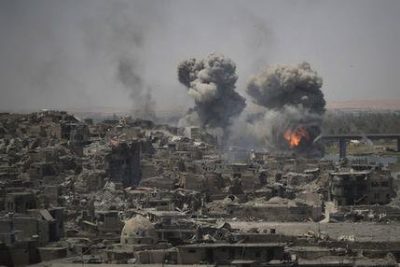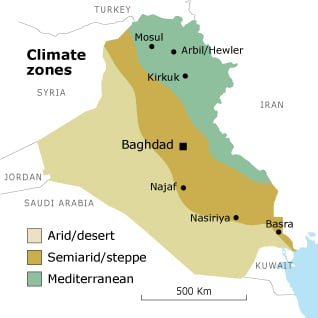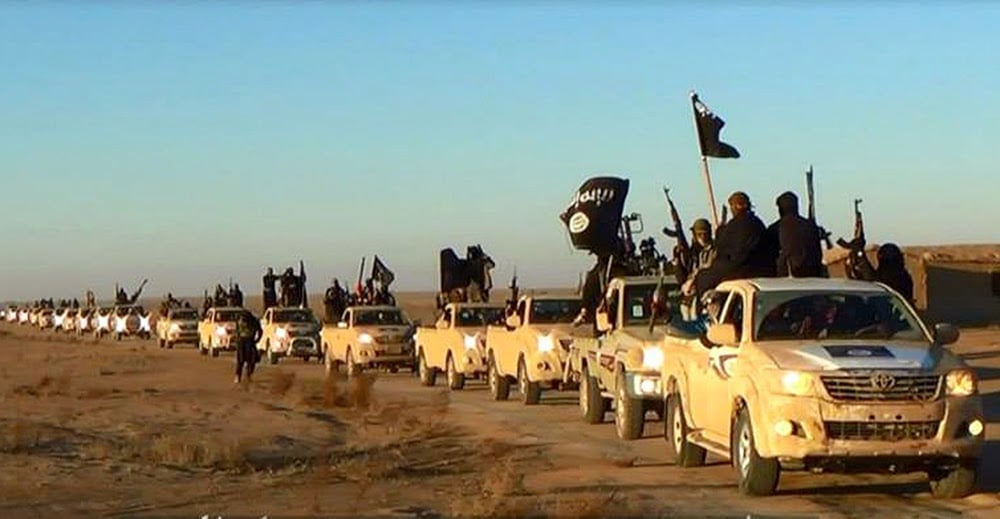Death and Destruction In the Wake of the “Liberation” of Mosul

It is worth recalling the history of the initial incursion of ISIS forces (Summer 2014) and the timeline extending from the occupation of Mosul in Summer of 2014 which was covertly supported by the US, to the “Liberation” of Mosul three years later which was also supported by the US and its allies.
We’re dealing with a diabolical military and intelligence agenda.
Moreover, it was only once the ISIS had captured Mosul and was firmly entrenched inside Iraq, that the US and its allies initiated two months later its “counter-terrorism” operation, allegedly against the ISIS.
With the so-called “Liberation” of Iraq (June-July 2017), it is important to reflect on Washington’s diabolical project.
The ISIS, a construct of US intelligence was dispatched to Iraq in Summer 2014. With limited paramilitary capabilities it occupied Mosul.
What would have been required from a military standpoint to wipe out the ISIS Daesh convoy with no effective anti-aircraft capabilities?

If they had wanted to eliminate the Islamic State brigades, they could have “carpet” bombed their convoys of Toyota pickup trucks when they crossed the desert from Syria into Iraq in June.
The answer is pretty obvious, yet not a single mainstream media has acknowledged it.
The Syro-Arabian Desert is open territory (see map right). With state of the art jet fighter aircraft (F15, F22 Raptor, F16) it would have been –from a military standpoint– ”a piece of cake”, a rapid and expedient surgical operation, which would have decimated the Islamic State convoys in a matter of hours.
Iraqi forces were coopted by the US to let it happen. The Iraqi military commanders were manipulated and paid off, They allowed the city to fall into the hands of the ISIS rebels without “a single shot being fired”.
Shiite General Mehdi Sabih al-Gharawi who was in charge of the Mosul Army divisions “had left the city”. Al Gharawi had worked hand in glove with the US military. He took over the command of Mosul in September 2011, from US Col Scott McKean.
Had he been co-opted, instructed by his US counterparts to abandon his command?
Then in August 2014, Obama launched a so-called “counter-terrorism operation” against the ISIS, namely against terrorists who were supported and financed by the US, UK, Turkey, Saudi Arabia, Qatar and Israel.
Three years of extensive bombings under a fake counter-terrorism mandate.
America’s ultimate intent was to destroy, destabilize and fracture Iraq as a nation State. That objective has largely been achieved.
The “Liberation” of Mosul constitutes an extensive crime against humanity consisting in actively supporting the ISIS terrorists occupation of Mosul, and then waging an extensive bombing campaign to “liberate” the city.
Michel Chossudovsky, Global Research, May 30, 2018
Nazli Tarsi‘s carefully documented article below describes the cruel aftermath of the “Liberation” of Mosul
***
Like heavy fog, the stench of death fills the air in Mosul
by Nazli Tarsi
May 29, 2018
Throughout the nine months from the beginning of military operations to liberate Iraq’s north-western province in October 2016, thousands of men, women and children, as well as fighters, perished. The Pentagon refers to the ancient city of Mosul’s fallen civilian population as “unintentional” casualties, but locally they are still mourned as mothers and fathers, children and grandchildren, all caught in the crossfire of a war outside of their making.
In July last year, Iraqi Prime Minister Haider Al-Abadi announced the liberation of the final Daesh stronghold in the ancient city. Another ten months have now passed, yet the corpses of civilians and Daesh fighters still litter the ground in Mosul’s Old City. According to investigator Samuel Oakford of monitoring group Airwars, “There remains no official count of the dead in Mosul.”
Eleven thousand has been the largest figure cited by press agencies, but hundreds who are still missing may yet have to be added to any final total. The tally is likely to grow for at least the next six months, if not longer.
Efforts to dispose of dismembered and mutilated corpses have been as agonisingly slow as efforts to reconstruct a city that endured, according to Airwars, 1,250 air strikes to be liberated. Bodies are collected by Iraq’s Civil Defence teams and death certificates are then issued, but even their efforts have been limited, owing to the lack of funds and human resources to tackle the problem head-on.
The blistering heat of an Iraqi summer threatens to aggravate the adverse health risks associated with rotting corpses. Already, like heavy fog, the stench of death fills the air in Mosul. Greater efforts are needed desperately, but the neglect of the bodies has established itself as the norm; they are simply being left to rot.
The Iraqi authorities, both central and provincial, have defended themselves against allegations of neglect over this issue. Each blames the other for failure to exhume bodies trapped beneath the rubble, as families, offered no support, are left to fill in the blanks over the fate of their missing loved ones. The perceived identify of abandoned corpses has been the excuse that some federal officials have used in defence of their inaction.
Iraq’s Civil Defence teams have, in some instances, refused to clear corpses which they claim belong to “Daesh families”. Nevertheless, on 17 and 18 May alone, Civil Defence responders recovered as many as a 1,000 bodies.
Local volunteers and civil society organisations have explained the dilemma by pointing to the lack of specialist equipment and the means needed to clear the city. Mohammad Dylan, a member of the Wasel Tasel Team distributing relief items and offering support to devastated neighbourhoods and homes in the Old City, expects further delays. “Some of the areas are not safe for volunteer teams to travel to alone,” he told MEMO, “particularly in the Old City District, where the majority of bodies are concentrated.”
In the absence of a coordinated corpse removal campaign, local volunteers from Nineveh and other Iraqi provinces have assumed the responsibility that officials have shrugged off. Despite the slow pace of their work, they are seeing results for the first time since the defeat of Daesh last July.
Fatima Alani, senior researcher at the Amman-based Iraqi War Crimes Centre, cited “multiple reasons” for the situation being as it is. “Safe corridors that could have provided civilians trapped inside the city with a safe escape route were not secured,” she explained. “Moreover, we received evidence that throughout the struggle for the city’s liberation, civilians were obstructed or dissuaded from leaving”.
Last week alone, Alani pointed out, a total of 600 bodies were recovered in the space of 48 hours. She contends that the brutality that visited Mosul could have been avoided if civilian-populated centres were not deliberately hit by overwhelming force.
As buildings crumbled, the face of Mosul was changed beyond recognition. The scale of urban devastation has made it almost impossible for families to locate relatives that they fear are dead, or find out how they died. The pattern of the killing that has emerged suggests clearly that beneath every shattered building rotting corpses remain entombed.
While the River Tigris made it easy for the disposal of bodies, the city’s water supplies are now dangerously polluted. The head of the Nineveh Water Directorate has denied such claims, though, and assured city residents of the periodic testing and sterilisation of potable water. No independent evidence exists to verify his claims.
Mohammad Al-Azzawi, the deputy head of the medical centre in Alam, told state-owned Chinese news agency Xinhua that laboratory tests show the water from the river to be highly contaminated with faecal and intestinal bacteria. “The negligence we see and the abandonment of these corpses will give rise to different diseases,” he said. “It could result in another plague or anthrax. The longer they remain, the more toxic the effects of environmental pollution will be.”
Al-Azzawi added that we should not forget that the prolonged presence of corpses in the rubble and on the streets will affect the health of the residents left behind, and contaminate the city’s water facilities. “The spread of lethal strains of influenza and other deadly pathogens will put civilian lives at greater risk.”
While many questions remain unanswered, the most pressing are linked to the identities of newly-recovered corpses, especially those discovered inside what have been described as “killing rooms”, where countless bodies are layered messily on top of each other. Almost a year after Mosul’s liberation, not all of the bodies are subject to forensic tests to determine the cause of death and their identity.
The stench of death that hangs heavily over the corpse-infested city has arrested optimism about a hopeful future for its remaining residents. They may have lived through one of the ugliest wars in modern memory, but their battle for survival goes on.


